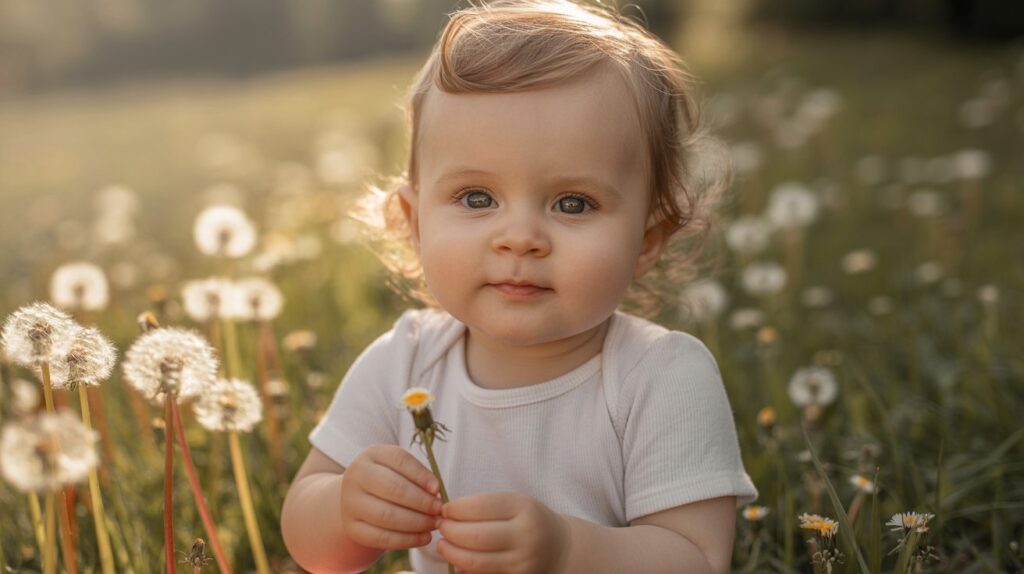Baby Milestones by Month: Your Complete Development Guide
*We may earn a commission for purchases made using our links. Please see our disclosure to learn more.
Every parent remembers that magical moment when their baby first smiled, rolled over, or took those precious first steps. These developmental milestones aren’t just adorable moments to capture on camera, they’re crucial indicators of healthy growth and brain development. Understanding what to expect during your baby’s first year can transform anxiety into excitement and help parents celebrate each incredible achievement along the way.
The journey of infant development is both universal and uniquely individual. While every baby follows a similar developmental pathway, each child progresses at their own pace, making their milestone journey a beautiful testament to human growth and potential.
“The first year of life is a period of remarkable growth and development. Understanding typical milestones helps parents support their child’s natural development while recognizing when additional support might be beneficial.”
– American Academy of Pediatrics
Key Takeaways
- Individual Timing: Babies develop at their own pace, with milestone ranges rather than exact dates
- Progressive Development: Each milestone builds upon previous achievements, creating a foundation for future skills
- Multiple Domains: Development occurs simultaneously across physical, cognitive, social, and emotional areas
- Environmental Support: Rich interactions and stimulating environments enhance developmental progress
- Professional Guidance: Regular pediatric check-ups help monitor development and address concerns early
The Foundation: Understanding Developmental Domains
Before diving into monthly milestones, it’s essential to understand that baby development occurs across four interconnected domains. Physical development encompasses both gross motor skills (large muscle movements) and fine motor skills (precise hand movements). Cognitive development involves thinking, learning, and problem-solving abilities. Social-emotional development includes forming relationships and expressing feelings, while language development covers both understanding and expressing communication.
These domains don’t develop in isolation. When a baby reaches for a toy, they’re simultaneously developing hand-eye coordination, spatial awareness, and goal-directed behavior. This interconnected growth makes each milestone achievement even more significant.
Month 1: The Awakening Period
During the first month, newborns are adjusting to life outside the womb while their nervous systems rapidly mature. Parents often worry about their newborn’s limited responsiveness, but incredible development is happening beneath the surface.
- Physical Milestones: Newborns demonstrate strong reflexes including the rooting reflex when their cheek is touched and the grasp reflex when objects touch their palms. They can lift their heads briefly during tummy time, though neck control remains limited. Their vision focuses best at 8-12 inches—perfectly designed for gazing at caregivers during feeding.
- Cognitive and Social Development: Babies begin recognizing familiar voices, especially their mother’s voice heard throughout pregnancy. They start showing preference for human faces over other patterns and may briefly track moving objects with their eyes.
- The challenge many parents face during this period is understanding their baby’s needs when communication is limited to crying. Learning to distinguish between different types of cries—hunger, discomfort, tiredness—becomes an essential parenting skill that develops through patient observation and response.
Month 2: Social Smiles Emerge
The second month brings one of parenting’s most rewarding milestones: the first social smile. This genuine response to interaction marks the beginning of intentional social communication and creates powerful emotional bonds between baby and caregivers.
- Physical Development: Head control improves significantly, with babies able to hold their heads up for longer periods during tummy time. They begin making smoother arm and leg movements as jerky newborn reflexes start to fade. Hand movements become slightly more purposeful, though still largely reflexive.
- Communication Milestones: Beyond smiling, babies begin making small throat noises and may start “cooing”—those delightful vowel sounds that melt parents’ hearts. They become more visually attentive, following faces and objects more consistently.
Parents often struggle with establishing routines during this period. While newborns need flexibility, gentle routine introduction around feeding and sleeping helps both baby and parents develop predictable patterns that support continued development.
Month 3: Discovering Hands and Voice
Month three marks a significant leap in self-awareness as babies discover their hands and begin intentional movement patterns. This period represents the transition from reflexive to purposeful actions.
- Motor Skill Development: Babies can now hold their heads steady when supported in a sitting position and push up on their forearms during tummy time. Hand control improves dramatically—they begin bringing hands together and may swipe at dangling toys, though grasping remains imprecise.
- Cognitive Growth: Visual tracking becomes more sophisticated, and babies show clear preferences for familiar faces. They begin studying their own hands with fascination, learning about cause and effect through their movements.
- Social Interaction: Vocalization increases with more varied cooing sounds and early attempts at back-and-forth “conversation” with caregivers. Babies become more socially responsive, showing excitement when familiar people appear.
Month 4: Rolling and Reaching
The fourth month introduces increased mobility and hand control, marking baby’s growing ability to interact with their environment purposefully.
- Physical Milestones: Many babies achieve their first roll from tummy to back during this period. Head control becomes well-established, and babies can support some weight on their legs when held in standing position. Reaching for objects becomes more accurate and purposeful.
- Fine Motor Development: Hand coordination improves significantly. Babies begin grasping toys with both hands and bringing objects to their mouths for exploration—their primary way of learning about object properties at this stage.
- Sensory Development: Color vision matures, allowing babies to distinguish between similar shades. They become more interested in detailed patterns and faces, spending longer periods examining objects and people.
Month 5: Sitting Support and Social Engagement
Month five brings increased social awareness and the beginning of independent sitting skills that will transform how babies interact with their world.
- Motor Achievements: While still requiring support, babies can sit with assistance and bear more weight on their legs. Rolling may become more consistent, and some babies begin rolling both directions. Object manipulation skills improve with better hand-to-hand transfer abilities.
- Communication Development: Babbling often begins around this time, with babies experimenting with consonant-vowel combinations. They show clear recognition of their name and respond differently to friendly versus stern voices.
- Social Milestones: Stranger awareness may begin emerging, showing that babies are developing stronger attachments to familiar caregivers. They become more interactive during play and may show frustration when desired objects are out of reach.

Month 6: Independent Sitting and Solid Foods
The six-month mark represents a major developmental milestone with the introduction of solid foods and achievement of independent sitting—both indicators of significant nervous system maturation.
- Physical Development: Independent sitting becomes possible for brief periods, freeing hands for exploration. This new perspective literally changes how babies view their world. Bouncing while supported becomes a favorite activity, and leg strength increases significantly.
- Feeding Milestones: The ability to sit independently coincides with digestive system readiness for solid foods. Tongue thrust reflex diminishes, and babies develop the coordination needed for spoon feeding and self-feeding finger foods.
- Cognitive Advances: Object permanence begins developing—babies start understanding that objects exist even when out of sight. This cognitive leap affects their play patterns and emotional responses to caregivers leaving their sight.
Month 7: Mobility Preparations
Month seven focuses on developing the strength and coordination necessary for crawling while refining sitting balance and hand skills.
- Pre-Crawling Development: While crawling timing varies widely, many babies begin showing crawling preparations—rocking on hands and knees, pivoting while sitting, or scooting backward. These movements build the core strength essential for future mobility.
- Fine Motor Refinement: Pincer grasp begins developing, allowing babies to pick up smaller objects between thumb and forefinger. This skill dramatically expands their ability to self-feed and explore different textures.
- Language Development: Babbling becomes more complex with longer strings of syllables. Babies may begin imitating sounds and show understanding of simple words like “no” or their name.
Month 8: Crawling and Exploration
The eighth month often brings true mobility as crawling emerges, fundamentally changing the parent-child dynamic and requiring new safety considerations.
- Mobility Milestones: Crawling patterns vary—some babies army crawl, others bear crawl, and some skip crawling entirely in favor of bottom shuffling. Regardless of style, increased mobility opens new learning opportunities while requiring enhanced supervision.
- Cognitive Development: Problem-solving skills emerge as babies figure out how to obtain desired objects. They begin showing clear preferences and may demonstrate early signs of independence by resisting help with tasks they want to attempt alone.
- Social-Emotional Growth: Separation anxiety may intensify as babies better understand when caregivers leave. This challenging phase indicates healthy attachment development, though it can be emotionally difficult for parents.
Month 9: Pulling to Stand and Communication
Month nine introduces vertical exploration as babies begin pulling themselves to standing positions, while communication skills become more sophisticated.
- Physical Achievements: Pulling to stand marks the beginning of preparations for walking. Leg strength and balance improve significantly, though independent standing remains brief. Cruising along furniture may begin for some babies.
- Language Milestones: First words may emerge, though pronunciation remains imprecise. Understanding of simple commands increases, and babies begin using gestures like waving or pointing to communicate needs and interests.
- Play Development: Toys become tools for more complex play. Babies enjoy cause-and-effect toys and may begin showing preferences for certain activities or objects, indicating developing personality traits.
Month 10: Cruising and Imitation
The tenth month refines standing skills while introducing cruising—walking while holding onto furniture for support. This phase builds confidence and strength for independent walking.
- Motor Development: Cruising becomes more confident and coordinated. Some babies begin standing independently for brief moments, though most still require support. Hand coordination allows for more complex manipulation of toys and feeding utensils.
- Cognitive Advances: Imitation skills flourish as babies copy actions, sounds, and facial expressions. This learning mechanism accelerates development across all domains and strengthens social connections.
- Emotional Development: Preferences become more pronounced, and babies may show frustration when unable to accomplish desired tasks. Learning to manage these early emotions with caregiver support builds resilience.
Month 11: Independent Standing and Advanced Play
Month eleven focuses on refining balance and coordination while developing more sophisticated play patterns and communication skills.
- Balance Development: Independent standing becomes more stable and prolonged. Some babies take their first independent steps, though this varies widely among individuals. Squatting to pick up toys demonstrates improving leg strength and coordination.
- Play Skills: Object manipulation becomes more intentional and creative. Babies enjoy stacking, banging objects together, and exploring cause-and-effect relationships through their actions.
- Communication Growth: Vocabulary may expand beyond first words, and understanding of simple instructions increases. Babies begin using communication more intentionally to meet their needs and express preferences.
Month 12: Walking and Independence
The first birthday represents a major milestone with many babies achieving independent walking, though the timeline varies significantly among children.
- Walking Milestones: Independent walking may emerge anywhere from 9-15 months, with 12 months being average. Early walkers aren’t necessarily more advanced—each baby follows their unique developmental timeline.
- Language Development: First words become clearer, and vocabulary may expand to several words. Understanding far exceeds expression, with babies comprehending much more than they can verbalize.
- Independence: Self-feeding skills improve significantly, and babies show strong preferences for independent exploration. This growing autonomy requires balancing safety with opportunities for learning through experience.
Supporting Healthy Development
Understanding normal milestone ranges helps parents provide appropriate support without over-stimulating or under-challenging their babies. Rich interactions, responsive caregiving, and safe exploration opportunities create optimal conditions for development.
- Environmental Considerations: Providing varied sensory experiences, adequate tummy time, and opportunities for social interaction supports development across all domains. Simple activities like reading, singing, and responsive conversation have profound impacts on growth.
- Individual Variations: Remember that milestone ranges exist for good reason. Premature babies may follow adjusted timelines, and individual temperament affects developmental expression. Focus on overall progress rather than specific timing.
- When to Seek Guidance: While development varies, significant delays across multiple domains or loss of previously acquired skills warrant professional consultation. Early intervention, when needed, can significantly impact outcomes.
Celebrating Every Achievement
Each milestone represents hours of behind-the-scenes brain development and physical growth. Celebrating these achievements—whether they occur early, on time, or later than expected—acknowledges the incredible work babies do every day to learn about their world.
The journey through baby’s first year is filled with wonder, challenges, and constant change. Understanding developmental milestones provides a roadmap for this journey while allowing parents to appreciate the remarkable process of human development unfolding before their eyes.
Remember that your baby is unique, and their developmental timeline will be their own. By providing love, support, and appropriate stimulation, parents give their babies the best foundation for continued growth and learning throughout their lives.
Conclusion
Baby milestones by month provide valuable insights into typical development patterns while highlighting the incredible complexity of human growth. From first smiles to first steps, each achievement builds upon previous learning and creates the foundation for future development.
Understanding these milestones empowers parents to support their babies’ growth while maintaining realistic expectations about timing and individual variation. The goal isn’t to accelerate development but to provide rich, responsive interactions that support natural growth patterns.
As babies progress through their first year, parents witness the remarkable transformation from helpless newborn to mobile, communicating toddler. This journey, while sometimes challenging, represents one of life’s most profound experiences, watching a new human being discover their capabilities and begin exploring the world around them.
Frequently Asked Questions
1. What should I do if my baby seems behind on milestones?
First, remember that milestone ranges exist because normal development varies significantly. If you’re concerned, document your observations and discuss them with your pediatrician. They can assess whether delays warrant evaluation or if your baby is simply following their own timeline. Early intervention, when needed, is most effective when started promptly.
2. Can I do anything to help my baby reach milestones faster?
While you can’t accelerate development beyond your baby’s natural pace, you can provide optimal conditions for growth. Responsive interactions, adequate tummy time, reading, singing, and safe exploration opportunities all support healthy development. Avoid pressure or overstimulation, which can actually hinder progress.
3. How do premature babies’ milestones differ?
Premature babies often follow milestones based on their adjusted age (chronological age minus weeks born early) rather than their birth date. A baby born 8 weeks early might reach 6-month milestones closer to 8 months chronologically. Discuss adjusted age expectations with your pediatrician.
4. Is it normal for babies to skip certain milestones?
Some babies may skip traditional crawling or show uneven development across different areas. This can be normal, but it’s worth discussing with your pediatrician. Overall development patterns matter more than achieving every specific milestone in order.
5. How can I tell if my baby’s development is on track overall?
Look for steady progress across multiple areas rather than focusing on specific timeline adherence. Babies should show increasing social engagement, developing motor skills, and growing communication abilities. Regular pediatric check-ups help monitor overall development and address any concerns professionally.




